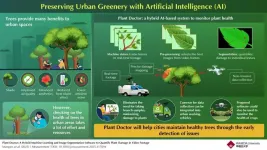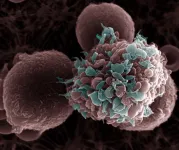(Press-News.org) In Sweden, around 18,000 workers are exposed to hexavalent chromium in their workplace. Hexavalent chromium is a powerful carcinogen that is released, for example, during welding of stainless steel or the manufacture of paints and rustproofing.
Thirty years ago, the limit for hexavalent chromium in Sweden was set at 5 micrograms per cubic metre of air. It is a technically calculated value that was determined based on what industry was considered to be able to handle at the time, rather than medical studies examining the level at which people start developing cancer.
That level is actually five hundred times higher than what we normally accept for carcinogens outdoors, so a reduction of the limit is necessary, says Karin Broberg, professor of occupational and environmental medicine at Lund University.
A research study from Lund University, published last year, collected breath, blood and urine samples from workers who had been exposed to the substance. The study showed that many workers are exposed to carcinogens unnecessarily and that the limit should be lowered. The current study included 89 people who were exposed to hexavalent chromium at work, and a control group of 47 people. The results show that workers experience significant changes in their cells long before disease develops, even though exposure is well below the Swedish limit.
In this study, more than 90% of workers were exposed to levels below the current limit and the majority (80%) were exposed at levels lower than the new proposed limit of 1 microgram per cubic metre of air. Nevertheless, the workers have subtle but significant changes in their cells’ microRNAs that are linked to lung cancer development.
Our bodily fluids contain small molecules, known as microRNAs, which regulate gene activity and are strongly linked to cancer development. They are also important for signalling between tissues and are particularly interesting to study as biomarkers of disease progression. These early biological changes are warning signals, which can help us recognise how serious diseases, such as lung cancer, develop. By identifying these molecular signals and understanding how they can predict risks, health surveillance can be strengthened for exposed workers and stricter safety regulations put in place. However, more studies are needed to confirm whether these changes can be used to predict the risk of cancer and determine whether the changes may be reversible.
“The study is particularly relevant given the Swedish Work Environment Authority's recent proposal to lower the limit for exposure to hexavalent chromium from 5 to 1 microgram per cubic metre of air. The current limit in Sweden is higher than in several other countries, including Denmark, which lowered its limit a few years ago following an alarming report. Denmark has now lowered its limit again to 0.25 micrograms, due in no small part to learning of our study last year. It is crucial that the Swedish authorities continue to act by further reducing the limit,” concludes Karin Broberg
END
Cellular changes occur even below the hexavalent chromium limit
2025-04-02
ELSE PRESS RELEASES FROM THIS DATE:
Study suggests a new way to curb social media’s body image toll
2025-04-02
PULLMAN, Wash. — Reflecting on how fitness posts on social media make them feel may help young women reduce the harmful tendency to compare themselves to idealized influencers and content online.
That’s according to a new study published in Health Communication that explores the impact of “fitspiration”—fitness-themed inspirational content—on young women’s body image, and whether short, daily reflections could lead to meaningful changes in their emotions and self-perception.
Led by Jessica Willoughby, associate professor of communication at Washington State University, the research found that sending young women twice-daily ...
Plant doctor: An AI system that watches over urban trees without touching a leaf
2025-04-02
Urban trees and plants do more than just beautify city landscapes. They purify the air, reduce urban heat islands, provide recreational spaces, and even boost property values. As essential components of sustainable urban ecosystems, plants silently contribute to our well-being. However, urban trees face many threats, including pests, diseases, and climate change, making it essential to keep their health in check.
Urban greenery monitoring has traditionally been a very labor-intensive process, requiring botanical expertise and considerable resources. With cities expanding ...
Study tracks chromium chemistry in irradiated molten salts
2025-04-02
UPTON, N.Y. — High temperatures and ionizing radiation create extremely corrosive environments inside a nuclear reactor. To design long-lasting reactors, scientists must understand how radiation-induced chemical reactions impact structural materials. Chemists at the U.S. Department of Energy’s (DOE) Brookhaven National Laboratory and Idaho National Laboratory recently performed experiments showing that radiation-induced reactions may help mitigate the corrosion of reactor metals in a new type of reactor cooled by molten salts. Their findings are published in the journal Physical ...
Scientists: the beautiful game is a silver bullet for global health
2025-04-02
Danish researchers, in collaboration with the Danish Football Association, have released a White Paper that describes football as an effective recipe in the prevention and treatment of lifestyle-related diseases.
The White Paper entitled Football as Prevention and Treatment - A White Paper Focusing on 10 Non-Communicable Diseases and Risk Factors – compiles and presents research and practical experience from over 20 years of implementing recreational football training in Denmark and several other countries.
The authors also provide best practice ...
Being physically active, even just a couple of days a week, may be key to better health
2025-04-02
Research Highlights:
New research suggests that participating in at least 150 minutes of moderate to vigorous physical activity in just two days had similar health benefits as distributing the activity throughout the week.
People who followed the “weekend warrior” approach, condensing physical activity into one or two days each week, had a significantly lower risk of death from all causes, cardiovascular disease and cancer, similar to those who engaged in activity throughout the week.
The study ...
High-fat diet promote breast cancer metastasis in animal models
2025-04-02
CNIO researchers discover that, in mice that eat a lot of fat, cancer cells travelling through the blood surround themselves with platelets, which act as an armor-like protection as they spread.
In addition, in animals with a fatty diet it is easier for tumor cells to 'nest' in other organs and give rise to metastasis of the primary tumor.
“These results anticipate a future in which dietary changes, together with the control of platelet activity, will complement antitumor treatments,” says Héctor Peinado, of the Spanish National Cancer Research Center (CNIO).
The study is published ...
A router for photons
2025-04-02
Applied physicists at the Harvard John A. Paulson School of Engineering and Applied Sciences (SEAS) have created a photon router that could plug into quantum networks to create robust optical interfaces for noise-sensitive microwave quantum computers.
The breakthrough is a crucial step toward someday realizing modular, distributed quantum computing networks that leverage existing telecommunications infrastructure. Comprising millions of miles of optical fiber, today’s fiber-optic networks send information between computing clusters as pulses ...
Nurses and AI collaborate to save lives, reduce hospital stays
2025-04-02
NEW YORK, NY (April 2, 2025)--
April 2, 2025—An AI tool that analyzes nurses’ data and notes detected when patients in the hospital were deteriorating nearly two days earlier than traditional methods and reduced the risk of death by over 35%, found a year-long clinical trial of more than 60,000 patients led by researchers at Columbia University.
The new AI tool, CONCERN Early Warning System, uses machine learning to analyze nursing documentation patterns to predict when a hospitalized patient is deteriorating before the change is reflected in vital signs, allowing for timely, life-saving ...
Multi-resistance in bacteria predicted by AI model
2025-04-02
An AI model trained on large amounts of genetic data can predict whether bacteria will become antibiotic-resistant. The new study shows that antibiotic resistance is more easily transmitted between genetically similar bacteria and mainly occurs in wastewater treatment plants and inside the human body.
"By understanding how resistance in bacteria arises, we can better combat its spread. This is crucial to protect public health and the healthcare system's ability to treat infections," says Erik Kristiansson, Professor at the Department of Mathematical Sciences at Chalmers University of Technology and the University of Gothenburg in Sweden.
Antibiotic ...
Tinker Tots: A citizen science project to explore ethical dilemmas in embryo selection
2025-04-02
EMBARGOED UNTIL 09:00 BST WEDNESDAY 2 APRIL
Tinker Tots: A Citizen Science Project to Explore Ethical Dilemmas in Embryo Selection
Researchers at the University of Oxford, University of Exeter, and the National University of Singapore Yong Loo Lin School of Medicine present a new, interactive study.
Oxford, 2 April 2025: When choosing an embryo for implantation during in vitro fertilization (IVF), would you consider its chances of developing a health condition? What about traits like creativity, intelligence, ...






